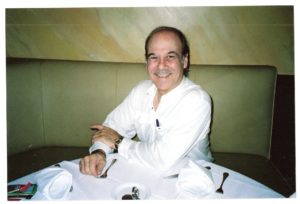The Bramson Archive: A Look at Some of the Gems Part III
[AdSense-A]
As previously discussed herein, The Bramson Archive is the largest collection of Florida East Coast Railway and Florida transportation memorabilia in the world: it is larger than the state museum’s and any of the various university museum’s collections (of like items, of course, not their entire collections) and larger than the Flagler Museum’s collection, the same disclaimer holding true in regard to that institution’s collections. In addition, it is the largest private collection (private as opposed to the museums) of Miami memorabilia and Floridiana in America. Suffice to say, there are a number of areas o
f superlatives which, indeed, qualify that particular group as the largest in public or private hands within the scope of that specific kind or type of collectible, and for the next several columns we shall present and discuss those areas for the enjoyment of our eager readers.
Of my thirteen different talks on South Florida local and Florida transportation history, two are what we refer to as our “adult show and tell talks” and it is to those two talks that I bring the memorabilia directly related to the topic.
The first of said talks is “The History of Discrimination in Greater Miami,” which is half Jim Crow and segregation and half restricted clientele. I am, incidentally, the only person in the state who gives that talk, to which I bring the memorabilia, the booklets, brochures, documents, photographs, postcards and signs illustrating the talk’s topic. Much (if not most) of the time the attendees are shocked by what they see, for the talk factually and documentedly illustrates, using the items and objects noted immediately above, to explain what the talk is all about, and it is neither funny nor cynical, but, rather, a talk which shows what life was like during those two tawdry and terrible eras.
As a side comment, it should be noted that that talk is made possible by the fact that The Bramson Archive maintains the largest collection of black Miami and Florida memorabilia that exists in—now note the disclaimer—white hands in the country. With that statement it should be evident to our readers that collections such as those maintained by Miami’s Black Archive near downtown Miami are certainly larger, but that does not either diminish or negate the importance of the collection maintained by The Bramson Archive.
Part of the talk is the debunking of several of the myths related to both groups (our “Debunking the Greater Miami Myths” presentation is a separate talk), particularly “the i. d. cards” non-factual fol-de-rol regarding the “black people had to carry i. d. cards on Miami Beach” story, which is false because, for a good few years, anybody who worked in a retail store, food or beverage operation or night club or cocktail lounge had to have a Miami Beach Police-issued i. d. card. There is, of course, more to the story but when you come to hear both talks you will learn what the truth is and what the facts are.
The second debunking is the “Oh, I remember the signs that read ‘No Jews/No Dogs,’” and the answer is always the same, “no, you don’t, because there were no signs that read ‘No Jews/No Dogs’ and if the five hotels that did have signs that read “No Jews” had a sign that read “No Dogs” it was fifty feet away from the other sign.
So what makes the Bramson Archive’s collection of discriminatory racial and religious memorabilia so large and so important? First, of course, is the sheer volume of material, partly referred to above. Second is the fact that the collection is (as noted by the new American Museum of Jewish History in ehhhhhPhilly) the largest collection of restricted clientele in the country.
As far as that segment of the collection, the interested researcher may avail him or herself of hundreds of items, including match books, postcards, booklet and brochures with couched phraseology, never using the words “No Jews” but always offering other delightful terminology, the most frequent of which was either “Gentile Clientele” or “Restricted Clientele” with numerous wording variations used by a number of other properties including those in Louisville, Kentucky and other locales which practiced that vile form or segregation, religious rather than racial. (Remember, in the South, segregation was practiced through statute, all of the Southern states having laws separating the races.)
I know that some of you would like to hear either or both talks, and we can, as Captain Picard would have said, “make it so.” You can reach me via Mr. Berkwitt (who is authorized to give you my email) so that we may arrange, and perhaps best of all, Unlike Miami’s walking fountain of misinformation (no names, please…we’re British!) who wants to be paid to go to the terlet, I give my talks to service clubs, fraternal organizations, veteran’s organizations, churches and temples at no cost or charge other than parking (if there is a charge) and the meal of the day for me and Myrna and my colleague who is there to assist me in showing the material. (It’s called “giving back to the community, something the other guy neither understands nor cares about) Best of all, no made-up hooey or nonsense (it is simply unbelievable what he has gotten away with, foisting nonsense on the public as if it were factual, which much of the time it is not), with all and everything discussed having been carefully documented. I’ll look forward to hearing from you, and, as always, with all good wishes. We’ll “see you” next issue.
[si-contact-form form=’2′]


